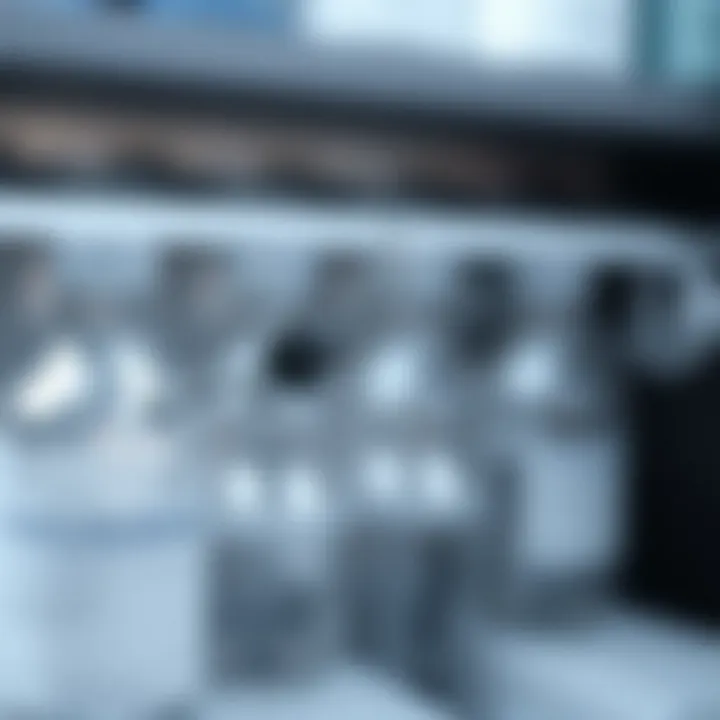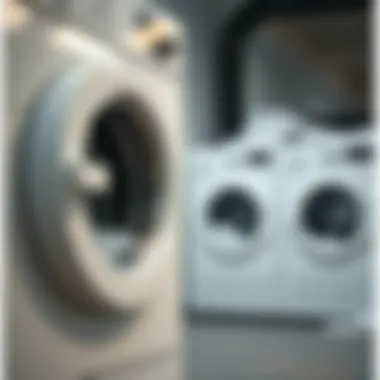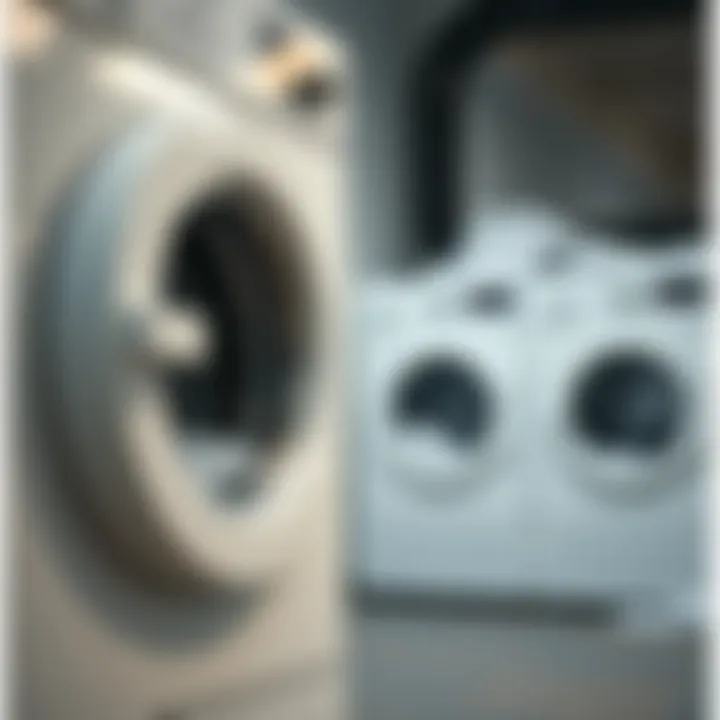Understanding Perchloroethylene in Dry Cleaning


Overview of the Topic
Perchloroethylene, often referred to simply as perc, is a synthetic chemical that has carved out a niche in the dry cleaning industry. Not only does it degrease and clean fabrics, but understanding its role also brings into focus broader environmental and health discussions. This solvent has been a staple for decades, adopted for its efficiency and effectiveness in removing stains and caring for delicate garments. Yet, as discussions evolve around sustainability, it becomes crucial to examine both the chemical itself and its implications, particularly concerning human health and the environment.
The significance of this topic cannot be overstated. Dry cleaning is an essential service, and its intersection with chemical use has implications for workers, consumers, and the planet. As regulations tighten and public awareness grows regarding safer cleaning options, understanding perchloroethylene's place in these processes is vital for makers, users, and advocates of clean practices.
Current Status and Challenges
As of now, perchloroethylene remains widely used in commercial dry cleaning, with millions of garments relying on it for maintenance and care. However, this reliance comes at a cost. Reports have indicated that perc is a potential carcinogen, drawing scrutiny from health agencies and prompting regulatory action in various regions. Some challenges faced today include:
- Health risks: Exposure to perc fumes can lead to various health issues, including dizziness, headaches, and long-term neurological effects.
- Environmental concerns: Improper disposal of perc can contaminate soil and water sources, making it a persistent organic pollutant.
These challenges necessitate a critical examination of dry cleaning processes and the materials used within. Moving away from perc isn't just a matter of switching solvents; it's an intricate dance with both environmental sustainability and human safety.
Sustainable Solutions
While the hurdles posed by perchloroethylene are significant, innovative solutions exist. The industry has begun pivoting towards alternative cleaning methods that minimize health and environmental impacts. Several noteworthy alternatives include:
- Wet cleaning: A method that uses water and biodegradable detergents, effectively cleaning fabrics without using hazardous chemicals.
- Liquid carbon dioxide cleaning: Involves using carbon dioxide in a supercritical state to extract dirt and oil.
Several case studies illustrate success with these alternatives. For instance, a dry cleaner in California transitioned to wet cleaning, significantly reducing its chemical usage and emissions while retaining high customer satisfaction. This shift not only benefited the environment but also reflected positively on their bottom line, showing that sustainable practices can be economically feasible.
Impact and Importance
The implications of using perchloroethylene extend beyond just dry cleaning. Its effects ripple outwards to touch ecosystems, local communities, and the future landscape of fabric care. Striking a balance between industry demands and environmental integrity is essential. Consumers are becoming increasingly aware of their choices, pushing for practices that safeguard public health and conserve resources.
Ultimately, the call for conservation and the adoption of sustainable practices resonate deeply in an era characterized by a heightened sense of responsibility toward the environment. As more businesses weigh the cost of sustainability against traditional practices, investing in eco-friendly alternatives not only mirrors public sentiment but ensures a cleaner planet for generations to come.
"Until we address the root of our environmental challenges through sustainable practices, our fight for a healthier ecosystem is akin to putting a band-aid on a bullet wound." — Environmental Scientist
Overall, understanding the journey of perchloroethylene in dry cleaning processes is pivotal for navigating future challenges and that's essential for nurturing a sustainable world.
Preamble to Perchloroethylene
When it comes to the dry cleaning industry, the name perchloroethylene, often simply known as perc, appears time and again. It’s a solvent that has played a pivotal role in this field for decades. Understanding its function is essential not just for industry professionals but also for anyone interested in the interplay between chemistry, environmental science, and fabric care.
Definition and Chemical Structure
To comprehend the relevance of perc in dry cleaning, one must first grasp what it actually is. This chlorinated organic compound is a colorless liquid with a sweet odor, and it belongs to the family of solvents. Its chemical structure can be denoted as C2Cl4, indicating that it consists of two carbon atoms and four chlorine atoms. Because of this arrangement, perc exhibits excellent solvency properties, making it an effective agent for removing dirt and stains from fabrics without causing damage.
"Perc's unique chemical makeup enables it to dissolve oil and grease with ease, which is essential for effective cleaning".
Historical Context
The journey of perchloroethylene in the dry cleaning sector began in the 1930s. It was discovered by accident, when a few savvy folks noticed that this solvent, used in degreasing metal parts, had the ability to effectively cleanse delicate fabrics like silk and wool. Fast forward to the 1950s, and you see perc gaining popularity rapidly, becoming the go-to choice for dry cleaners worldwide. Its effectiveness overshadowed concerns regarding health and environmental impact, leading to widespread adoption.
However, with increased awareness comes scrutiny. The latter part of the 20th century saw rising concerns about the potential health risks linked to perc exposure, prompting regulatory discussions.
As the industry stands at a crossroads today, balancing efficacious cleaning with the need for sustainable practices becomes critical for dry cleaners. Thus, understanding perchloroethylene is not just about its chemical properties but also about recognizing its historical significance and the evolving narrative surrounding its use. Each aspect contributes to a nuanced understanding of its role in today’s environment-conscious world.
The Role of Perchloroethylene in Dry Cleaning
Perchloroethylene, commonly termed perc, is a pivotal component in the dry cleaning industry. It plays a crucial role due to its unique properties that make it exceptionally effective for cleaning fabrics without soaking them in water. This section unpacks the significance of perc in dry cleaning activities, focusing on its operational mechanisms, the benefits it offers, and the considerations that dry cleaners must keep in mind while using this solvent on various fabrics.
Mechanism of Action
The effectiveness of perc as a dry cleaning agent lies in its ability to dissolve oils and grease. When clothes are immersed in perc, the solvent penetrates the fabric fibers, effectively loosening dirt and stains. Unlike water, perc does not swell the fibers, thus making it suitable for delicate fabrics that could be damaged by wet cleaning methods.
The cleaning cycle typically involves the following steps:
- Soaking: The garments are soaked in perc, allowing it to seep into the fabric.
- Agitation: The machine gently moves the clothes to help the perc work its magic on the stains.
- Separation: After cleaning, the dirt-laden solvent is pumped away.
- Distillation: The used perc is purified and recycled, which is essential for the eco-efficiency of dry cleaning operations.
This reuse not only reduces waste but also ensures that cleaners can maintain a consistent quality of cleaning over time.


Benefits of Using Perc
Utilizing perchloroethylene in dry cleaning presents numerous advantages that enhance the quality of garment care:
- Effective on Stains: Perc is noted for its unmatched ability to dissolve a wide range of stains, including oils, grease, and even some dyes that water cannot tackle.
- Fabric Safety: Many fabrics that are sensitive to water, like silk or wool, hold their shape and integrity when cleaned with perc. It minimizes the risk of shrinkage and color bleeding.
- Quick Drying Time: Since perc evaporates quickly, garments spend less time in the drying process compared to traditional wet cleaning methods. This leads to faster turnaround times for customers, which can attract more business.
- Environmentally Friendly Options Available: While perc itself has raised environmental concerns, advancements in technology and new regulations have introduced methods that minimize its ecological impact, allowing for a more sustainable approach to dry cleaning.
Considerations for Fabric Types
While perc excels in cleaning many types of clothing, it's important to recognize that not all fabrics react the same way. Dry cleaners need to consider several factors regarding fabric types before employing perc:
- Delicate Fabrics: Lighter, softer materials like chiffon or tulle may require special treatment or may not be suitable for perc cleaning at all to avoid damage.
- Color Stability: Certain dyed fabrics may bleed if not tested carefully, necessitating caution and prior testing before using perc.
- Embellishments and Finishes: Clothes with heavy embellishments or finishing touches like sequins may require hand cleaning or alternative methods.
Understanding the compatibility of fabrics with perc is essential to ensure optimal cleaning results while safeguarding the garments' integrity.
"The key to successful dry cleaning with perc lies in understanding both the product and the fabric. A little precaution goes a long way."
Health Risks Associated with Perc
Understanding the health risks associated with perc is crucial, especially in an era where environmental and health-conscious practices are gaining traction. Perchloroethylene, while effective as a cleaning agent in dry cleaning, does pose potential health hazards that can’t be brushed off. As the dry cleaning industry grapples with shifts towards greener alternatives, it’s essential to keep these risks front and center. The consequences of prolonged exposure to perc can range from acute symptoms to long-term health implications, making awareness key.
Exposure Routes and Symptoms
People can be exposed to perchloroethylene through several routes. The most common is inhalation, particularly for workers in dry cleaning facilities where vapors can accumulate in the air. Skin contact may occur when handling wet garments or during the cleaning process. Here are some notable symptoms that indicate exposure:
- Dizziness and headaches: Often the first signs, these headaches can catch someone off guard.
- Nausea: Feeling sick to your stomach might not seem serious, but it can hinder daily activities.
- Fatigue: Persistent tiredness can plague those regularly exposed, impacting productivity.
- Irritation: Eyes and skin may feel irritated, leading to redness or discomfort.
Recognizing these symptoms is vital for both workers in the industry and consumers who might unknowingly bring home residual perchloroethylene on cleaned garments.
Long-term Health Impacts
Long-term exposure to perc raises even more serious concerns. Epidemiological studies have suggested that chronic exposure could lead to more severe health conditions:
- Neurological effects: Problems such as memory issues and cognitive decline can emerge.
- Liver and kidney damage: The organs struggle to detoxify, leading to potential long-lasting health issues.
- Increased cancer risks: There have been associations found between perc exposure and certain types of cancer, such as bladder cancer.
Ongoing research continues to uncover these risks, but it's abundantly clear that the stakes are high. This calls for a heightened vigilance when handling this solvent.
Regulatory Health Guidelines
The regulatory landscape surrounding perchloroethylene reflects the mounting evidence of its health risks. Both the Environmental Protection Agency (EPA) and the Occupational Safety and Health Administration (OSHA) have established guidelines to minimize risks. Key measures include:
- Permissible Exposure Limits (PELs): OSHA sets an eight-hour time-weighted average of 100 parts per million (ppm) for workplace exposure.
- Labeling requirements: Facilities must provide adequate warnings about the dangers associated with perc.
- Safe handling protocols: This includes ventilation systems in dry cleaning facilities to mitigate inhalation risks.
Groups advocating for public health and safety continue to push for stricter measures to protect workers and consumers alike. The emphasis on regulatory compliance symbolizes an ongoing battle between maintaining traditional cleaning methods and enhancing health protections.
"Awareness is half the battle won. Knowing the risks associated with perchloroethylene is crucial for both workers and consumers."
Understanding these health risks equips the industry and consumers alike with the tools needed to advocate for safer practices. As the conversation shifts towards sustainability, addressing these dangers remains essential.
Environmental Concerns Regarding Perc
When discussing perchloroethylene (commonly called perc), it's crucial to shine a light on its environmental ramifications. While it holds significant utility in the dry cleaning industry, the undeniable drawbacks to ecosystems call for serious contemplation. The topic of environmental concerns surrounding perc delves into how this solvent interacts with our planet's air, soil, and water. Awareness of these factors is vital, not solely for conservationsists but for all stakeholders including consumers, businesses, and policymakers.
Impact on Soil and Water
Perc poses notable threats to soil and water systems. When mismanaged, the chemical can leach into the ground, polluting soil and potentially contacting groundwater sources. For many communities that depend on well water, contamination risks become alarmingly pertinent. The groundwater can become toxic, leading to long-term repercussions for public health and local ecosystems. This contamination does not present itself easily, as it can oftentimes go unnoticed for years until the adverse effects become evident.
"Water pollution from perc often leads to dire consequences, impacting everything from drinking water supplies to agricultural productivity."
The cleaning cycles used in dry cleaning facilities may also contribute to water pollution. If wastewater containing perc is improperly disposed of, rivers and lakes could suffer. Marine life exposure to such chemicals can disrupt ecosystems, adversely affecting aquatic species biodiversity. This chain of events illustrates why regulatory frameworks for perc disposal must be not just existing, but strictly adhered to and enforced.


Air Quality Issues
The volatility of perc adds another complex layer to its environmental implications; it contributes to air quality issues. During the drying process, fumes can escape into the atmosphere, leading to indoor air pollution problems within dry cleaning facilities and potentially neighbouring environments. For workers and residents nearby, prolonged exposure to volatile organic compounds (VOCs) such as perchloroethylene has been linked to numerous health concerns.
Moreover, the atmospherical degradation of perc can result in the formation of harmful secondary pollutants, which exacerbate smog conditions. Communities situated near major dry cleaning establishments may find themselves grappling with air that doesn’t meet safety standards, emphasizing the urgent need for better air management practices and technological investments in emissions reduction.
Sustainable Practices in Dry Cleaning
In tackling the environmental concerns regarding perc, the industry can explore alternative practices that sweep over traditional dry cleaning methods. The focus should pivot towards introducing sustainable cleaning practices. Some alternatives, like wet cleaning techniques, utilize water and biodegradable detergents as substitutes for harmful chemicals like perc. These methods not only reduce environmental impacts but also address public health concerns associated with chemical exposure.
Investments in green cleaning technologies are also vital. Innovations such as liquid carbon dioxide cleaning or biodegradable solvents can significantly diminish reliance on perchloroethylene, offering a cleaner approach to fabric care. In addition to reducing the environmental footprint, implementing such solutions can also enhance a business's public image, appealing to the growing consumer preference for eco-friendly options.
In summary, addressing the environmental concerns surrounding perc is not just an obligation but a path to future-proofing the dry cleaning industry. Engaging in sustainable practices and being proactive about potential contamination can lead to healthier communities and ecosystems.
Alternatives to Perchloroethylene
The ever-evolving conversation around dry cleaning has led to significant interest in alternatives to perchloroethylene (perc). The drawbacks of perc, from health and environmental concerns to regulatory pressures, have prompted both professionals and consumers to seek out safer, greener options. This section aims to illuminate the various alternatives that not only offer effective cleaning but also align with the growing demand for sustainability in industrial practices.
Green Dry Cleaning Solvents
One of the most promising alternatives to perc are green dry cleaning solvents. These solvents are crafted from environmentally friendly ingredients that minimize hazardous waste. For instance, carbon dioxide (CO2) cleaning has gained traction. This method employs pressurized CO2, transforming it into a liquid state to dissolve dirt and oil without the harsh side effects associated with traditional solvents. The process ends with the CO2 returning to a gaseous state, leaving no toxic residue behind.
Additionally, many establishments are turning to bio-based solvents derived from natural sources. These solvents are often non-toxic and biodegradable, offering a safer experience for both workers and consumers. Some popular options include:
- Soy-based solvents
- Citrus-based formulations
- Water-based agents
Using these alternatives not only supports eco-friendly practices but may also attract a customer base that values sustainability.
Wet Cleaning Techniques
Wet cleaning is another viable alternative gaining popularity in the industry. It utilizes water and specially formulated soaps to clean garments, making it an environmentally responsible choice. This method employs advanced technology to control the washing process, ensuring that fabrics are treated gently while achieving high levels of cleanliness. It has the added benefit of reducing the risk of ruining delicate clothes, as these techniques are designed to care for fabrics effectively.
Wet cleaning is particularly beneficial for items labeled as "dry clean only". By adapting washing machines specifically designed for delicate fabrics and controlled drying processes, many cleaners have successfully eliminated perc without compromising on quality. The "wet cleaning" process is characterized by:
- Precision in temperature control
- Gentle agitation levels
- Natural detergents
Many dry cleaners are pleased to provide this option, often promoting it as a proven alternative to traditional chemical methods.
Emerging Technologies in Fabric Care
Innovation in fabric care is continually on the rise, presenting additional alternatives to perc. From nanotechnology to new cleaning agents, the industry is witnessing exciting breakthroughs.
For instance, enzymatic cleaners harness natural enzymes to break down stains effectively while being gentle on fabrics and the environment. Additionally, technologies utilizing plasma cleaning show promise as an eco-friendly method that uses electrical discharges to eliminate dirt and bacteria without harmful chemicals.
The industry's shift toward these cutting-edge solutions highlights a broader trend where sustainability converges with technological advancement. Not only do these technologies improve efficiency, but they also contribute to a greener future for fabric care—and that is certainly worth celebrating!
Further details on green alternatives can be found on Wikipedia and EPA.gov.
By embracing these alternatives, dry cleaners can not only safeguard public health and the environment but also enhance their reputation in an increasingly eco-conscious market.
Regulatory Landscape for Perc Use
Understanding the regulatory landscape for perchloroethylene (Perc) is crucial for any discussion surrounding its use in dry cleaning. Regulations not only denote compliance standards for businesses, but they also offer insight into the broader implications for public health and the environment. These regulations often stem from a growing concern over the potential risks associated with Perc, including health hazards and environmental impacts. Furthermore, they help shape the future practices of the dry cleaning industry.
Federal Regulations
On the federal level, the regulation of perchloroethylene falls primarily under the Environmental Protection Agency (EPA). The EPA has classified Perc as a volatile organic compound (VOC) that can contribute adversely to air quality. Over the past decades, there have been tightening regulations concerning its use. Notably, the Clean Air Act requires significant reporting and monitoring for facilities that utilize Perc. Under this framework, dry cleaners must possess permits that dictate specific operational stipulations related to emissions. Businesses found in violation of these regulations could face hefty fines and possibly suspension of their operations until compliance is reinstated.
These regulations not only enforce a standard for air quality but provide guidelines for proper waste disposal and spill prevention. The aim is to minimize human exposure and damage to the environment. It’s a balancing act, ensuring that while the industry continues to thrive, it also takes responsibility for its ecological footprint.


State-Specific Policies
While federal guidelines set a baseline, many states have opted for stricter regulations tailored to local conditions. This patchwork of policies can create challenges for businesses operating across state lines. For example, California’s AB 32 establishes stringent air quality goals that affect Perc usage significantly, pushing for a marked decrease in the substance over time. In contrast, states like Texas may have more lenient regulations, reflecting less pressing air quality concerns.
These localized policies often reflect the priorities and environmental conditions of a state, which can result in a mixed regulatory environment. Dry cleaning businesses must stay vigilant and informed about their own state regulations, which sometimes include mandates for reporting emissions or using pollution control equipment. Non-compliance can not only affect business operations but also tarnish reputations within communities increasingly conscious of eco-friendliness.
Industry Compliance Standards
In addition to federal and state regulations, the dry cleaning industry itself has developed compliance standards that are recommended for best practices. Organizations like the Drycleaning & Laundry Institute (DLI) and International Fabricare Institute (IFI) work closely with both governmental bodies and industry stakeholders to create guidance documents and standards for safe Perc use. These guidelines are essential for informing business owners about best operational practices, including the use of advanced equipment designed to limit Perc emissions.
Industries that adhere to these compliance standards often report not only improved environmental outcomes but also enhanced consumer trust. When dry cleaners actively demonstrate their commitment to sustainability through compliance, they can attract a clientele that values eco-conscious practices. Customer preferences are shifting towards businesses that prioritize environmental integrity, making compliance not just a regulatory obligation but also a significant business advantage.
"The regulatory landscape surrounding perchloroethylene usage is not just about compliance; it's a reflection of societal values and the growing imperative for sustainable practices in all industries."
The Future of Dry Cleaning and Perc
The future of dry cleaning, particularly in relation to perchloroethylene, is an intriguing subject characterized by rapid change and adaptation. As consumers and businesses alike grow more environmentally conscious, the impacts of traditional cleaning methods and the chemicals involved have come under scrutiny. This aspect encourages a deeper dive into the viability and relevance of perc, a solvent widely used for decades. As we explore this topic, several specific elements emerge that highlight the importance of both understanding current trends and anticipating future developments in the industry.
Market Trends and Consumer Preferences
The dry cleaning landscape is evolving, with consumer preferences steering the ship toward more eco-friendly options. Shoppers today are increasingly aware of the detrimental effects of chemicals, including perc, on health and the environment. As a direct response to this rising awareness, many dry cleaning establishments are diversifying their offerings.
- Demand for Transparency: Customers are searching for information about what goes into their cleaning process. Quite a few establishments now disclose the solvents they use—and many consumers prefer biodegradable or less hazardous products.
- Growth of Green Cleaning Services: A noticeable uptick in businesses advertising their eco-friendly credentials points to a significant market opportunity. These establishments often embrace alternatives that are less harmful while still effective.
- Shifting Priorities: With sustainability at the forefront of various industries, dry cleaning is no exception. A breathable brand that prioritizes environmental responsibility can capture the attention and loyalty of a discerning customer base.
The convergence of these trends paints a picture where perc may soon find itself sidelined, replaced by greener alternatives that resonate more with consumers who prioritize sustainability.
Advancements in Chemical Research
As researchers delve deeper into sustainable practices, significant strides in chemical research are paving the way for new cleaning technologies. These advancements not only challenge the long-held dominance of perc, but also offer cleaner, safer options for fabric care.
- Bio-based Solvents: Innovations in formulations include substances derived from natural sources, which show promising properties akin to perc without the associated health risks. These cuts across traditional boundaries, appealing to both manufacturers and consumers concerned about hazardous chemicals.
- Reduction of Toxicity: Researchers are scrutinizing the molecular structures of existing cleaning agents to find ways to alter them, leading to products that retain efficacy while being less harmful. The push is not merely toward replacements, but toward the evolution of the cleaning agents themselves.
- Increased Efficiency in Detergency: Cutting-edge techniques utilize nanotechnology to enhance cleaning performance. Such advancements signify a monumental leap toward systems that are environmentally safe but highly efficient too.
These developments suggest that innovators are keen on creating the next generation of fabric care products, potentially fully displacing conventional solvents like perc in the process.
Shifts Towards Sustainability
The ongoing shifts toward sustainability represent a transformative wave that carries the potential to redefine the dry cleaning industry. As public policies increasingly enforce stricter regulations on harmful substances, the trend pushes dry cleaners to re-evaluate their operational practices.
- Legislative Influence: Many states and countries are tightening regulations against harmful chemicals, which significantly pressures firms to either adapt or perish. As legislators recognize the long-term environmental impact of traditional practices, compliance becomes non-negotiable.
- Industry Cooperation: Work in tandem with policymakers can lead to certification programs encouraging eco-friendly practices. Participation in such programs often comes with the benefit of not just regulatory compliance but also market gains through consumer trust.
- Consumer Advocacy and Education: A well-informed public is pivotal in the push towards sustainability. Education on the impacts of chemicals used in dry cleaning helps cultivate an environment where sustainability becomes a shared goal.
In summary, the future of dry cleaning will likely see a marked shift away from perc towards greener methods. While perc has undeniably played a crucial role in determining fabric care standards, the emerging preferences and advancements suggest that its reign may soon come to an end.
Ultimately, the constant tug-of-war between tradition and innovation in solvent usage is a reflection of our growing commitment to environmental health and safety.
For further insights and a deeper exploration into the topic, you can visit Environmental Protection Agency or National Institute for Environmental Health Sciences.
The future may yet favor those who bend their practices towards sustainability without compromising quality, marking a notable evolution in dry cleaning.
Ending
The conclusion is a crucial element of this article as it encapsulates the key themes discussed and encourages readers to reflect on the vital intersection of chemistry and environmental sustainability in the dry cleaning industry. Summarizing the main arguments helps to reinforce understanding and retention of the information presented, especially when considering the importance of perchloroethylene in fabric care.
Recap of Key Points
The article has journeyed through various aspects of perchloroethylene's role in dry cleaning. In summary, here are the highlights that have emerged:
- Chemical Properties: Perchloroethylene, commonly known as perc, is an effective solvent for greasy stains and dirt, making it a staple in the dry cleaning process.
- Health Risks: There are significant health risks associated with perc, primarily linked to exposure through skin contact, inhalation, and environment. Keeping informed about these hazards is crucial for both workers and consumers.
- Environmental Impact: The use of perc poses questions about air and water quality, necessitating conversations about sustainable practices in dry cleaning.
- Regulatory Environment: Understanding the various federal and state regulations governing the use of perc can offer insights into ensuring safer practices in the industry.
- Alternatives and Innovations: There are promising alternatives and emerging technologies that provide safer and more environmentally friendly options, reflecting a shift towards sustainability in fabric care.
Final Thoughts on Perchloroethylene's Future
Going forward, the fate of perchloroethylene in the dry cleaning industry will hinge on several factors, including regulatory changes, advancements in chemical research, and evolving consumer preferences. The trends suggest a proactive movement towards greener alternatives and sustainable practices, but the degree to which these will replace or integrate with traditional methods remains to be seen.
Moreover, consumer education plays a indispensable role in shaping these trends, as people become increasingly aware of the implications of their choices. Ultimately, the industry's future will likely require a balance between efficacy in cleaning and a genuine commitment to environmental responsibility. In light of this evolving landscape, maintaining an open dialogue about chemicals like perchloroethylene and their impacts will be essential as we navigate through the complex waters of fabric care in a modern context.
"To move forward, we must learn from the past and thoughtfully engage with the materials we use every day."
For more in-depth information regarding perchloroethylene, consider exploring additional resources such as Environmental Protection Agency and National Institute for Occupational Safety and Health.



